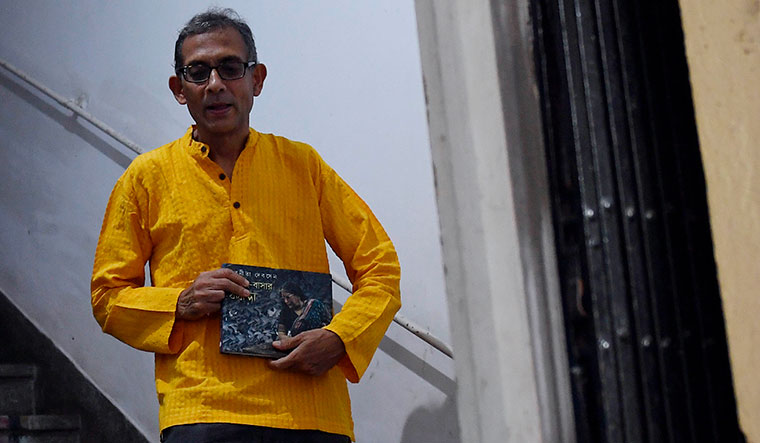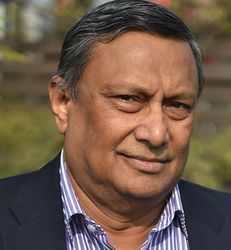EVEN A FEW DAYS ago not many in India would have heard about Abhijit Banerjee, Esther Duflo or Michael Kremer outside the small community of economists and those working in the development field. Today, every Indian who watches television or reads a newspaper is aware that they have been awarded the Nobel Prize in economics for something called randomised control trials, or RCT. The big coverage of this news is partly because much of the work using RCT has been based in India, but it is mainly because Banerjee is an Indian.
I met Banerjee’s parents, both economists, long before I met him. His mother Nirmala Banerjee—or Nirmala di, as we call her—was a professor at the Centre for Studies in Social Sciences in Kolkata. Much of her work has been on the informal sector and in women’s studies. His father, Dipak Banerjee, taught economic theory at Presidency College. He, along with Mihir Rakshit and others, produced several generations of fine economists at Presidency.
During his early years in Kolkata, Banerjee played with friends from a neighbourhood slum. Such companionship cutting across social boundaries is not uncommon in Kolkata. This close and early exposure to poor people, curiosity about their lives, a liberal environment at home and the rigorous professional discipline of his parents probably account for the combination of human empathy and rigorous research which is the hallmark of his professional work.
I first interacted with Banerjee in 2012, when he got in touch to ask if I could help one of his PhD students at Harvard get access to income tax data which the Central Board of Direct Taxes (CBDT) had withdrawn from the public domain. That student was Mihir Sharma, a leading economic journalist, and the data he sought was not for his own research but for a research project led by Thomas Piketty. Piketty’s work, Capital in the Twenty-first Century, dealing with the rising inequality in the long-term dynamics of capitalism, became a best-seller and his analysis of income tax data from several countries is an important part of that work. But I completely failed to extract anything from the CBDT, which was quite possessive about its income tax data. It was years later that Arvind Subramanian as chief economic adviser was able to help Piketty get his income tax data from India.
I met both Banerjee and Piketty again at a conference in Neemrana in 2014. That was where I met Duflo for the first time when I had the privilege of chairing a session where she was presenting her paper. By then Banerjee and Duflo were quite well known for their pioneering work using RCT as a tool. Duflo was Banerjee’s student before she became his co-researcher. They are now married and have two children. Banerjee and Duflo cofounded the Abdul Latif Jameel Poverty Action Lab (J-PAL).
Kremer first established himself for his work in economic theory, but has moved on to rigorous RCT-based empirical research and he closely collaborates with Banerjee and Duflo. It was during his early years of field work in Kenya that Kremer pioneered the idea of adopting the tool of randomised control trials, a standard testing technique in medical science and agriculture, to research in the social sciences. His research engagement with India is no less than that of Banerjee. Precision Agriculture for Development (PAD), a non-profit organisation he cofounded, has applied the RCT technique to help lakhs of farmers in India to raise farm productivity and their incomes.
The Royal Swedish Academy of Sciences awarded the prize to Banerjee, Duflo and Kremer for “their experimental approach to alleviating global poverty”. The core idea of this experimental approach is to apply an intervention or ‘treatment’ to a randomly selected sample of subjects from a larger population. The outcome of interest of the treatment group is then compared with that of the rest of the population, the control group. Since they belong to the same population and are similar to the treatment sample in all other respects, the researcher is able to isolate the effect of the treatment. Such randomised control trials are standard practice in the medical and some other fields, but relatively new in the social sciences. It provides rigorous evidence of the impact of the treatment.
Three key features sum up this approach. By breaking down grand development issues into specific questions about how poor people see and respond to certain interventions in their real life conditions, this approach looks at questions of development from below, through the subaltern lens of the poor. Second, the RCT technique enables rigorous testing of propositions about specific cause-effect relationships or what works and what does not. Third, these test results provide the basis for evidence-based policymaking.
The RCT approach has been applied across many fields. J-PAL, for instance, has conducted about 1,000 RCT evaluations in 83 countries in health, nutrition, health care services, education, finance, labour markets, governance, the environment and social support programmes. Each RCT seeks to answer some very specific questions, but collectively the sum of all RCT findings is leading to a whole different evidence-based paradigm of development. According to some reports, RCT-based evaluations have led to policies that have already improved the lives of over 100 million people worldwide.
RCT has had its share of critics, including Angus Deaton, who was earlier given the Nobel Prize for his work on the rigorous estimation of poverty and inequality. However, the criticism is not so much about the value of RCTs but about their limits. For instance, if trials cannot fully ensure that the treatment group and control group are identical then the treatment effect becomes ambiguous.
India has been a major focus of J-PAL research led by Banerjee and Duflo. While it has covered many fields, the impact in education and health has perhaps been the most impressive. For example, the finding that when children are grouped and taught according to their learning levels rather than their age or grades, and assisted through remedial teaching, there are vast gains in learning outcomes led to the ‘Teaching at the Right Level (TRL)’ programme. It is well known that government schools in Delhi have seen a huge leap in quality, but less known that the ‘Chunauti’ programme in Delhi government schools is in fact an application of the TRL approach. In health care, J-PAL’s finding that poor citizens are very sensitive to even small variations in drug prices has led to a WHO programme for free distribution of deworming pills. I have also referred earlier to the work being done in Indian agriculture by PAD.
Let me conclude on a positive note with a quote from the laureates themselves. In an article published on October 16, Banerjee and Duflo had this to say: “...what gives us real hope for the future of policymaking in India is to see in the corridors of power as in the makeshift offices of NGOs and in press rooms all over the world not only a willingness but often even a desire to engage with facts, even uncomfortable facts.”
Mundle is distinguished fellow at the National Council of Applied Economic Research.



